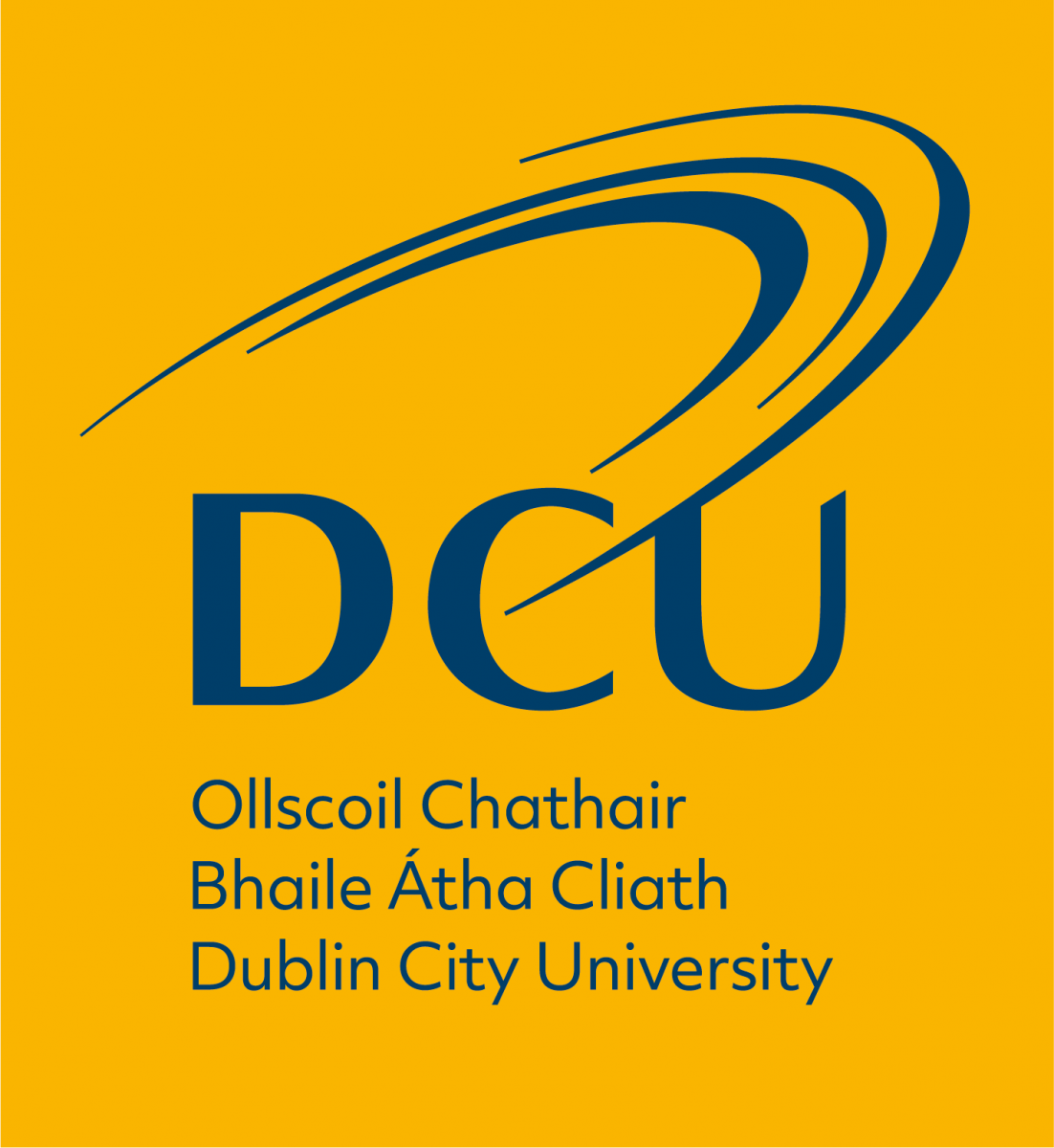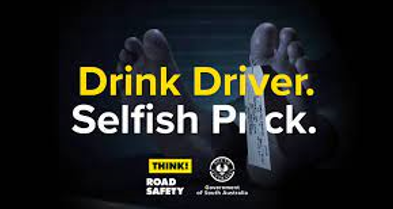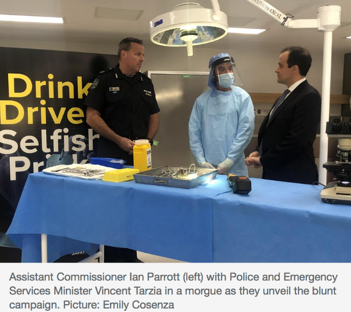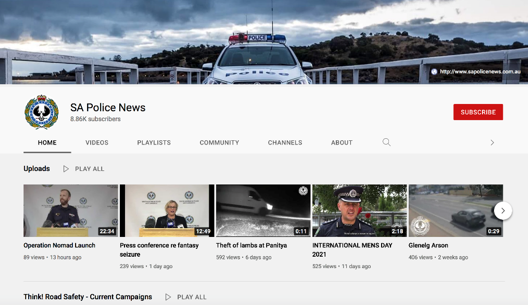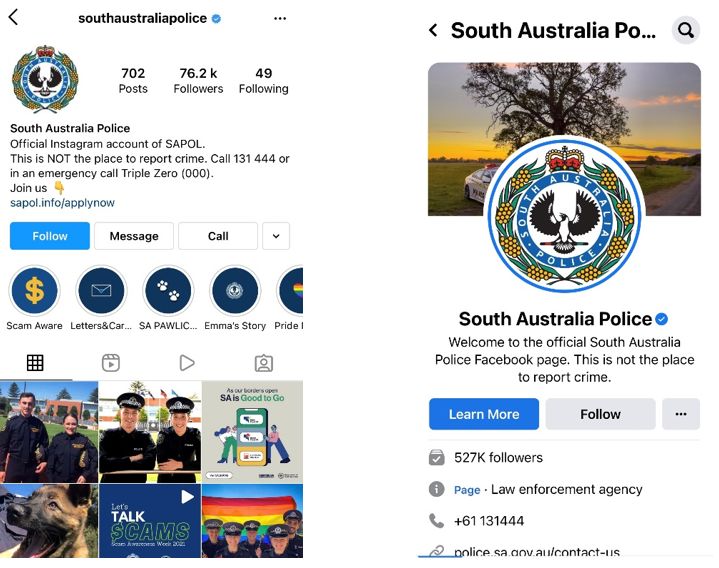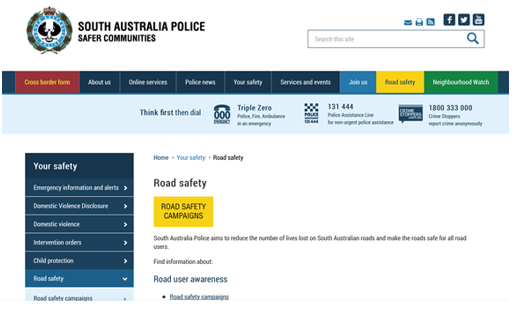Executive summary
This article assesses and analyses the ‘Drink Driver Selfish Prick’ road safety campaign, which aims to educate motorists on the dangers of driving under the influence of alcohol (Cosenza, 2021). This campaign is a public awareness campaign, meaning that its aim is “to inform a community's attitudes, behaviours and beliefs, with the intention of influencing them positively in the achievement of a defined purpose or goal” (Sawyers, 2006, p.1).
Public awareness messages provide “general background information about an issue” and are used to “reinforce the importance of informed action and behavioural change” (ibid). The ‘Drink Driver Selfish Prick’ campaign is a recent road safety campaign that was released in March of 2021. The campaign was developed by the Southern Australia police force, with its purpose being to influence a change in behaviour towards drink driving. The campaign was developed after extensive research revealed the motivations of those who drive under the influence; the main motivation being inconvenience (Think! Road Safety - Selfish Prick Campaign 2021, 2021). The ‘Drink Driver Selfish Prick’ campaign targets the demographic who are “most represented in drink driving statistics”; young men between the ages of twenty and forty (ibid). The campaign was promoted internally within Australia, particularly in the region of Southern Australia. It includes a series of television, radio, print and digital advertisements, and it also received publicity through press releases, interviews and widespread media coverage locally and nationally. Traditionally, awareness campaigns have been “oriented by fear appeal theories” and have “adopted traditional media [...] to spread their message” (Graffigna et al., 2011). This can be applied to the ‘Drink Driver, Selfish Prick’ campaign, as through fear appeal, the communications objectives of the campaign were to educate, change the behaviour of and influence the opinions of the public in relation to drink driving (Waddington, 2021).
In order to analyse this campaign entirely, I must look at how the key elements of a public relations campaign can be applied to the ‘Drink Driver Selfish Prick’ campaign. This includes stakeholders, the PESO model, images and numbers, ethics and crisis communications. I will analyse each of these elements thoroughly, clearly stating how they can be applied to my chosen campaign. To conclude, I will provide an evaluation of the campaign and discuss the success or failure of the campaign from a public relations perspective.
Stakeholders
Stakeholders are recognised as “any group or individual who is affected by or can affect the achievement of an organization’s objectives” (Rawlins, 2006, p.2). In relation to public relations, the stakeholders are those who are affected or can affect a campaign and its purpose. Not every stakeholder is of equal importance, yet all stakeholders play an important role in the overall success of a public relations campaign. ‘Publics’ is the term that is used to identify stakeholders in public relations literature (Rawlins, 2006). Because public relations is not directed at “the general public as an amorphous mass”, in order for campaigns to be effective, there must be focus on “specific groups within society” (Maloney and McGrath, 2019, p. 58). Therefore, every organisation communicates to a variety of different stakeholders or publics through their campaigns. Publics are often segmented “by demographics, geographics, or psychographics” (Rawlins, 2006, p.2), like in the ‘Drink Driver, Selfish Prick’ campaign, where the target reach is men aged twenty to forty.
In public relations literature, there has not been much effort put into identifying stakeholders according to the relationship they have with an organisation. Sometimes stakeholders can simply be viewed as internal and external, however the most effective way of identifying stakeholders from public relations literature is through the linkage model developed by Grunig and Hunt (cited in Rawlins, 2006). The linkage model consists of “four linkages that identify stakeholder relationships to an organization: enabling linkages, functional linkages, diffused linkages, and normative linkages” (ibid, p.3). Let’s briefly explain each of these in turn:
Enabling linkages
Enabling linkages “identify stakeholders who have some control and authority over the organization, such as stockholders, board of directors, governmental legislators and regulators, etc” (ibid). In this campaign, the Government of South Australia is an enabling linkage. The South Australian Police force is a government agency, therefore the Government of South Australia has some control over the information and content that the South Australia Police release (South Australia Police, 2021).
Functional linkages
Functional linkages are the stakeholders that are “essential to the function of the organisation” (Rawlins, 2006, p.4). The functional linkages to the organisation are the employees of the South Australia Police force. The employees who develop their road-safety campaigns are extremely important as they are an essential part of this campaign and the organisation as a whole.
Diffused linkages
The diffused linkages are stakeholders that do not have “frequent interaction with the organisation”, but they become involved due to the actions of the organisation (ibid). These publics include the media, the target reach of a campaign and the general public.
Normative linkages
Normative linkages are “associations or groups with which the organisation has a common interest” (ibid). In relation to the South Australia Police force and their road safety campaigns, the ‘Think! Road Safety’ initiative by the Government of South Australia is a stakeholder as it shares the common interest of raising awareness around road safety. The ‘Think! Road Safety’ initiative worked in association with the South Australia police in developing the ‘Drink Driver, Selfish Prick’ campaign.
In relation to the campaign specifically, is it important to identify the primary stakeholders and the secondary stakeholders. The primary stakeholders of the ‘Drink Driver, Selfish Prick’ campaign, who were directly affected by the campaign are; the Southern Australia police and the target reach of men aged twenty to forty. The Southern Australian police are primary stakeholders of this campaign because they are the organisation who developed the campaign. Young men, aged twenty to forty, are also primary stakeholders because they are the target reach of the campaign. The target reach are the ones most affected by objectives of the campaign. They are both important stakeholders as both the organisation and the target reach are those most affected by the objectives and response.
The secondary stakeholders of this campaign, who were not directly affected by it were; the media, local communities and the general public. The media, local communities and the public are important stakeholders in the campaign, as ultimately they determine the reach and the success of the campaign. The role of the media as a stakeholder is important, as the media play a crucial role in the promotion of the campaign.
PESO
In modern public relations literature, media content has been categorised into four quadrants; paid, earned, shared and owned media, also referred to as PESO (MacNamara et. al, 2016). The PESO framework is a tool used in Public Relations that involves the integration of different forms of media (Waddington, 2018). It can be employed to analyse how an organisation executes an integrated campaign through the use of various forms of media. Here, the framework can be used to analyse the ‘Drink Driver Selfish Prick’ campaign, as a variation of different media forms were evidently used to execute this campaign.
Paid Media
Paid media refers to the traditional forms of advertising and content that are contracted between an organisation and the mass media (MacNamara et. al, 2016). Over the past century, paid media has been the dominant form of promotional media content (ibid), with organisations heavily focusing on paid media for publicity. In relation to the ‘Drink Driver, Selfish Prick’ campaign, paid media refers to the advertisements that were developed and used as part of the campaign. These forms of paid media included television advertisements, radio advertisements, print advertising and digital advertising.
Television Advertisements
The television advertisements for the ‘Drink Driver, Selfish Prick’ campaign consist of two different advertisements; the ‘Excuses’ advert and the ‘Consequences’ advert (SAPOL - Road safety campaigns, 2021). This approach was taken by the Southern Australia police as they wanted to “get inside the heads of drink drivers, and contrast their excuses with the potential consequences for themselves and those around them” (Murphy, 2021). With the videos being “direct, to the point and thoroughly hard-hitting”, they follow a “drunk driver making his way home from the pub” (AsiaAdJunkie, 2021). The driver comments on his own actions, telling viewers that all drink drivers know deep down that their actions are those of a ‘selfish prick’. These video advertisements provide viewers with a different perspective; outlining the excuses the man makes for drink driving, against the consequences his actions could have. Both videos are thirty seconds long and include the same male character. Through the use of a powerful narrative and graphic images, the videos are extremely impactful in making viewers think about the consequences of driving under the influence of alcohol.
Radio Advertisements
Three different radio advertisements were developed as part of the ‘Drink Driver, Selfish Prick’ campaign (SAPOL - Road safety campaigns, 2021). These radio advertisements consist of the master radio advert which is thirty seconds long, and two shorter adverts that are fifteen seconds long. The radio advertisements use the same audio as the videos, with the voice of the male character discussing both the excuses made by drink drivers and the consequences of their actions.
Print Advertisements (billboards, posters and newspapers)
The print advertisements for billboards, posters and newspapers share the same theme, displaying an image of feet in a morgue. In the image, there is a tag attached to the foot of the deceased which shares the deceased's personal information. The tag reads; “David Smith, Male, aged 35, cause of death: single car” (SAPOL - Road safety campaigns, 2021). These details match the demographic of the campaign’s target reach. This approach is simple yet very effective, as the reality of drink driving is conveyed to the target reach through morbid imagery. The graphic image, along with the words “Drink Driver, Selfish Prick”, make for a powerful print advertisement that displays the overall objective of the campaign. Still images from the video advertisements were also used in newspapers articles about the campaign.
Digital Advertisements on Social Media
The digital advertisements for this campaign shared the same theme as the print advertisements; the image of feet in a morgue. Two short video clips were the main digital advertisements that were used as part of the campaign, which consisted of the image of feet in the morgue, alongside the phrase ‘Drink Driver, Selfish Prick’. A vertical video and a horizontal video were released in order to accommodate different technologies and social media platforms (SAPOL - Road safety campaigns, 2021). The Southern Australia police also released digital advertisements to their Facebook page, which provided alarming figures after a weekend “state-wide operation” that targeted both drink and drug driving (South Australia Police, 2021). These digital advertisements included evidence of high volumes of drink-drivers within the region, and aided in creating further awareness of the on-going issue of drink driving in Southern Australia.
Earned Media
Earned media refers to the publicity that is generated through press releases, interviews and other media related activities (MacNamara et. al, 2016). Earned media is commonly recognised as third party coverage and is when a campaign receives attention from the media (Rene, 2020). Third-party coverage or endorsement ultimately is the desired result of a public relations campaign. The ‘Drink Driver, Selfish Prick’ campaign received widespread coverage within the Australian media. Through interviews with the press and coverage in the news and newspapers, the campaign generated large-scale publicity throughout the country and region of Southern Australia.
Interviews with the Press
Ian Parrott, Assistant Commissioner of the Southern Australia police, took part in interviews with the press that aided in gaining publicity for the campaign (Cosenza, 2021). He explained in his interviews that the campaign was designed to be “confronting” for those who have chosen to ignore all previous warnings surrounding drink-driving (ibid). Ian Parrott’s interviews were effective in developing attention surrounding the campaign, as his unapologetic response to the harsh campaign sparked media attention. Parrott stated that the Southern Australian Police make “no apologies for the aggressive nature” of the campaign, with their aim being to start conversations about drink-driving amongst the target audience and the general public (ibid). Police and Emergency Services Minister, Vincent Tarzia, also took part in interviews with the press in which he expressed his disappointment surrounding how “messaging around drink-driving needed to be more confronting” for some people (ibid). Tarzia told reporters; “If you drink and drive, this is where you could end up: in a morgue cold and alone” (ibid). The harsh approach of the campaign was reiterated by both Parrott and Tarzia in their interviews with the press; with both of them further enhancing the objectives of the campaign. Both interviews were covered by journalists and published to a variety of media outlets. This developed further publicity for the campaign as the interviews reached a wider audience through journalism.
News and Newspapers
The ‘Drink Driver Selfish Prick’ campaign received coverage in both the news and newspapers. A variety of Australian news outlets published articles about the campaign online, including ‘Ad News’ and ‘News.com.au’ (Adnews.com.au, 2021; Cosenza, 2021). The ‘Drink Driver Selfish Prick’ campaign also attracted publicity and coverage through newspapers within Australia.
Shared Media
Shared media refers to the forms of media that are open to the public to contribute to (MacNamara et. al, 2016). Shared media allows “followers, friends and subscribers” to contribute to conversations, and provide their own opinions on an organisation’s campaign (ibid). Most commonly, social media platforms such as Twitter and Facebook would be associated with shared media (ibid). The shared media that is associated with the ‘Drink Driver Selfish Prick’ campaign is the social media accounts of the Southern Australia police. The Southern Australian police have social media accounts on Twitter, Facebook, YouTube and Instagram, in which they share information and raise awareness about issues in the region. Because of the Southern Australia police’s presence on social media, the public have been able to interact with the ‘Drink Driver, Selfish Prick’ campaign online, and contribute to the conversation surrounding the consequences of drink driving. Especially through the comments sections, the public were able to interact with the campaign, giving their thoughts and opinions on the effectiveness of the campaign.
Social media has had a positive impact on the public relations industry as it has made it possible for organisations, like the South Australia Police, to “communicate directly with public groups and bypass the filtering process of journalists” (Valentini, 2014, p.170). Social media has been “praised” for its influence on society, in which it allows anyone to “participate and freely contribute to the online environment” (ibid). The connectivity that social media creates between organisations and its publics allows organisations to identify their stakeholders’ thoughts, concerns and preferences in relation to their campaign. Social media is also a “cheap and interactive” way for organisations to communicate and reach their target audiences (ibid. The use of social media in the ‘Drink Driver, Selfish Prick’ campaign was effective as it extended the reach of the campaign.
While there are no statistics to confirm if the campaign’s social media content reached the target audience of men aged twenty to forty, according to Barnhart (2022) of Sprout Social, recent social media demographics revealed that this age demographic are the most frequent users of the chosen social media platforms. Barnhart’s findings are as follows:
Facebook demographics and usage:
-
Largest age group: 25-34 year olds
-
Gender: 57% Male
-
Twitter demographics and usage:
-
Largest age group: 18-29 year olds
-
Gender: 61.6% Male
-
Instagram demographics and usage:
-
Largest age group: 25-34 year olds
-
Gender: 51.8% Male
Through the integration of a variety of social media platforms, the South Australia Police effectively utilised the platforms most used by the target demographic. The aim of integrating multiple platforms was to reach a wider audience, ensuring the campaign’s message reached a high proportion of the target demographic.
Owned Media
Owned media refers to the publications and digital media sites that are created and controlled by an organisation; such as websites, blogs and official social media pages (McNamara et. al, 2016). The owned media associated with the ‘Drink Driver, Selfish Prick’ campaign would be the Southern Australia police’ own website and social media platforms. The website of the Southern Australia police has a section dedicated to road safety, where they publish information regarding current or existing campaigns (SAPOL - Road safety campaigns, 2021). Under each campaign, there are links to all of the campaign’s media content. This provides easy access for the public to engage with the campaign and its content. Although their website provides valuable information and awareness surrounding road safety, their social media platforms are more effective due to the extended reach they receive. The Southern Australia Police have social media accounts on Twitter, Instagram, Facebook and YouTube, in which they share information about their current and existing campaigns.
Images and Numbers
Images and numbers are frequently used in public relations campaigns. Images and numbers are an effective way of providing the public or target reach with visual interpretations of the message being conveyed in the campaign. Images have the power to “connect with people instantly and emotionally” (Smith Ellis, 2015), while numbers “provide people with information quickly and effectively” (Groves, 2019). Both images and numbers were used as part of the ‘Drink Driver, Selfish Prick’ campaign.
Images
In the constant battle for media coverage, a “well-chosen image, info-graphic, photo” or well produced videos can make a strong impact on an effective public relations campaign (Shaw, 2019). People often find images to be far more impactful than words. According to researchers from the Massachusetts Institute of Technology, the brain can process entire images in 13 milliseconds (Smith Ellis, 2015). Therefore, through the use of powerful images in a campaign, the human brain processes the message being conveyed by the organisation much easier. In the ‘Drink Driver, Selfish Prick’ campaign, graphic images are used to convey the consequences of driving under the influence of alcohol. In the video advertisements, one image that clearly stands out is that of the car crashed into the tree (Think! Road Safety - Selfish Prick Campaign 2021, 2021). This graphic image evidently conveys to the public the potential and devastating consequences of driving under the influence.
The image used for the print and digital advertisements also displays the consequences of drink driving, with the image being of feet in a morgue. Although morbid, the uncomfortable yet powerful image executes the objective of the campaign; to highlight the dangers and consequences of drink driving. This image instantly conveys to the public that they too could end up dead in a morgue if they were to drive under the influence of alcohol.
Numbers
Like images, numbers can reach people faster than words (Groves, 2019). Therefore, the use of numbers is very effective in public relations campaigns. In the ‘Drink Driver, Selfish Prick’ campaign, numbers were used in digital video advertisements that were published to the South Australia police’ social media platforms. If the numbers used in a campaign do not “grab” the consumer’s attention within a number of seconds, you have lost their interest (ibid). Therefore, when using numbers in a campaign, it is crucial that they catch the attention of the audience. In these digital advertisements, the numbers were highlighted in a different colour to the rest of the text, in order to stand out and draw attention to the figures being presented. This approach is extremely effective, as the figures instantly catch the attention of the consumer.
Ethics
Ethics involves what is right and wrong. Society has developed various social and legal rules that “act as a framework or guide to behaviour” (Theaker, 2016). Moral rules and legal requirements share a close relationship, yet they are not always synonymous. Ethics focuses more on the aspect of morals; with organisations setting moral rules to maintain social relations to use when making decisions (ibid). Public relations bodies have established codes of ethics to regulate behaviours of those in the industry. Although public relations practitioners follow particular codes of ethics, the industry has become known for its “ethical slipperiness” (Harrison and Galloway, 2005). Even with the existence of guides, models and professional codes of ethics, there is “no guarantee of ethical behaviour” (ibid). In relation to the ‘Drink Driver, Selfish Prick’ campaign, issues arose regarding the ethics.
Despite the overall success of the campaign, there were still a number of complaints made by the public that questioned its ethics. The Australian Ad Standards revealed a list of the most complained about advertisements in 2021, with the ‘Drink Driver, Selfish Prick’ advertisements coming in third place (Madigan, 2021). The campaign received forty-seven complaints regarding the harsh language and the vilification of men within the campaign (ibid). These complaints about the campaign fell under the discrimination or vilification of gender and inappropriate language in the AANA code of ethics (Ad Standards Community Panel - Case Report, 2021).
Before releasing the campaign, South Australians were surveyed “to determine if the phrase was too offensive to appear in the public domain”, however results conveyed that the public gave positive feedback to the “direct language” that was used (Drink drivers under spotlight as cold, hard truth laid bare at mortuary, 2021). Journalist, Zac Crellin, showed his support of the campaign, writing; “If you’re upset by an anti-drink-driving campaign, maybe get your priorities in check. People who drink and drive are indeed selfish pricks” (Crellin, 2021).
The Southern Australia police made statements regarding the concerns surrounding the ethics of the campaign, however, refused to apologise for its harsh or aggressive nature (Cosenza, 2021). When reacting to complaints surrounding a campaign, representatives of an organisation should be understanding of the public’s concerns. If the Southern Australia police were to react to complaints they receive in the future, it would be advisable to be apologetic for any offense that they caused members of the public. Therefore, this would aid in maintaining a positive image for both the representative and the organisation as a whole.
Crisis Communications
Crisis communications can be “triggered by a sudden event or a rapidly developing problem” (Crisis Communications: After 9/11 - [Powerpoint], n.d.). Drink-driving is not a new phenomenon or issue, however, it is a rapidly developing problem amongst drivers in southern Australia. Therefore, this campaign reacts to the crisis of drink driving within the region.
This campaign places particular focus on the crisis amongst men aged twenty to forty, who are the demographic most associated with drink driving in Australia (Think! Road Safety - Selfish Prick Campaign 2021, 2021). The campaign has been described as an “aggressive approach” to combating the problem of drink-driving in Australia, with the use of harsh language and images (Cosenza, 2021). The use of the word ‘prick’ in the title of the campaign resonates with the target audience as it is part of the language most commonly used among Australian men between the ages of twenty and forty (ibid). The use of the word ‘prick’ was effective in resonating with the target reach, however as previously stated, this use of language was subject of complaints from members of the public (Ad Standards community panel, 2021). Although these complaints were not considered a ‘crisis’ in response to the campaign, the South Australian police needed to react to these complaints in the correct manner in order to maintain a positive image for the organisation.
Crisis Management
As the issue of drink driving is not a sudden or new phenomenon, the South Australia police did not have to react quickly to this crisis. However, if the South Australia police had to publicly react to a sudden event or crisis, they would need to have a good understanding of crisis management. Crisis management is a “process designed to prevent or lessen the damage a crisis can inflict on an organization and its stakeholders” (Crisis Management and Communications, 2007). Crisis management should be approached by an organisation in three different stages; “pre-crisis, crisis response, and post-crisis” (Institute for Public Relations, 2007). Pre-crisis involves preparation and prevention, crisis response involves how the organisation responds to the crisis and post-crisis looks at the organisation improving their approach to crises in the future (Crisis Management and Communications, 2007). It is crucial that an organisation reacts to a crisis in the correct manner in order to maintain a positive and reputable image for the organisation and its representatives.
Issues Management
While drink driving is not considered a crisis, it can be viewed as an issue that must be managed. In the late 1970s and early 1980s, issues management emerged as a way for organisations to “preventatively confront matters affecting them” instead of re-actively responding (Ciszek, 2015, p.449). Through anticipating change, issues management focuses on “strategic planning, policy, implementation and evaluation” in order to balance potential opportunities and threats (ibid). Early forms of issues management viewed it as a “problem solving mechanism” that was used to address issues of public concern (Woods, 2019, p.333). Through the development of anti-drink driving campaigns, the South Australia police are implementing issues management. The ‘Drink Driver Selfish Prick’ campaign was developed to address the issue of drink-driving and to try reduce the levels of drink-driving in the region. By developing this campaign, the South Australia police have pro-actively taken preventative measures to tackle drink-driving, treating it an as issue that must be constantly managed rather than a crisis they must respond to.
Evaluation
The ‘Drink Driver, Selfish Prick’ campaign was a successful campaign for a number of reasons. Evidently, the South Australia police force communicated their campaign effectively through various media channels. Through the integration of digital and print media, the campaign and its message was easily communicated to the target audience and the general public. Through choosing the correct channels of communication and using a blunt approach, the campaign clearly met its objective of educating the public on the consequences associated with drink driving. Key aspects of the campaign that aided in its success were; the integration of different media forms, the use of images and numbers and the ‘aggressive’ approach that got ‘straight to the point’ of the campaign.
Measuring Public Relations (and the Campaign’s) Success
Measuring public relations helps to define the success of a public relations campaign (Waddington, 2021). Public relations measurement should always include an “organisational plan”, in which the communication objectives of the campaign are outlined (Waddington, 2021). The ‘Drink Driver, Selfish Prick’ campaign was successful as it fulfilled its primary objectives to educate, change the behaviour of and influence the opinions of the public in relation to drink driving. It has been illustrated that “local, personally directed campaigns [...] show by far the biggest effect on road accidents'' (Hoekstra and Wegman, 2011). This is evident from the statistics that emerged after the ‘Drink Driver Selfish Prick’ campaign was released, with drink driving rates hitting “their lowest point in 10 years because of the hard-hitting” ‘Selfish Prick’ campaign (Kemp, 2021).
Two of the best practices to measure public relations activities include the PESO framework and the Integrated Evaluation Framework (Waddington, 2021). The PESO framework is effective as “it encompasses all forms of integrated media” (ibid). Through my analysis of the campaign, I conveyed how the South Australia police evidently integrated paid, earned, shared and owned media into the ‘Drink Driver, Selfish Prick’ campaign. The Integrated Evaluation Framework provides a “standardised, integrated approach to measurement”, “starting from planning and setting objectives, through to implementing strategy and measuring and evaluating outcomes” (What is the AMEC Measurement Framework? : PR Agency One, 2021). The framework looks at objectives, inputs, activities, outputs, out-takes, outcomes and organisational impact (Waddington, 2021). This framework can be used to evaluate and measure the ‘Drink Driver Selfish Prick’ campaign.
Objectives
As stated previously, the communication objectives of the ‘Drink Driver Selfish Prick’ campaign were to educate, change the behaviour of and influence the opinions of the target reach and members of the public in relation to drink driving).
Inputs
The inputs define the target audience of the campaign; with men aged twenty to forty being the target reach of the ‘Drink Driver Selfish Prick’ campaign. The target reach was addressed in the campaign through the use of language commonly used amongst their age demographic and by using a male character in the advertisements.
Outtakes
The out-takes concern the reaction from the target audience. Overall, the response to the campaign was positive, however there were a number of complaints from the target reach regarding the “vilification of men'' through the campaign (Ad Standards Community Panel - Case Report, 2021). In the comments of social media posts made by the South Australia Police, some members of the target reach questioned why men were being targeted when both genders are responsible for drink driving (South Australia Police, 2021).
Outcomes
The outcomes concern the effect that communications had on the target reach (Waddington, 2021). Through the integration of various channels of communication, the campaign was easily accessible to the target reach. Especially with the campaigns’ presence on social media, young men were able to interact and communicate with the campaign.
Organisational Impact
The organisational impact concerns the evaluation of the campaign’s impact against its objectives. The impact of the campaign evidently aligned with the objectives of the campaign, as studies revealed that the campaign majorly affected the target audience (Kemp, 2021). Findings conveyed that “100 percent of 30-39 year olds said the advertisement would cause them to worry what others thought of them if they were to drink drive” (ibid). The South Australia police also revealed that in April 2021, a month after the campaign was released, the rate of positive alcohol detection tests “dropped from one per hundred tested drivers, to just 0.54 per 100 drivers” (ibid). These findings evidently show the impact of the campaign.
Conclusion
In conclusion, the ‘Drink Driver, Selfish Prick’ campaign was a successful public awareness campaign that achieved its overall objective. Through television, radio, print and digital advertisements, and publicity generated through press releases, interviews and widespread media coverage, the campaign reached its target audience and educated the general public about the consequences of drink driving. Key elements of a successful public relations campaign could be applied to the ‘Drink Driver, Selfish Prick’ campaign, including stakeholders, the PESO model, images and numbers, ethics and crisis communications. Therefore, it is evident that this campaign was a successful public relations campaign.
Word count: 5,105 words (excluding abstract and reference list)
References
For the full list of references, see the PDF file
